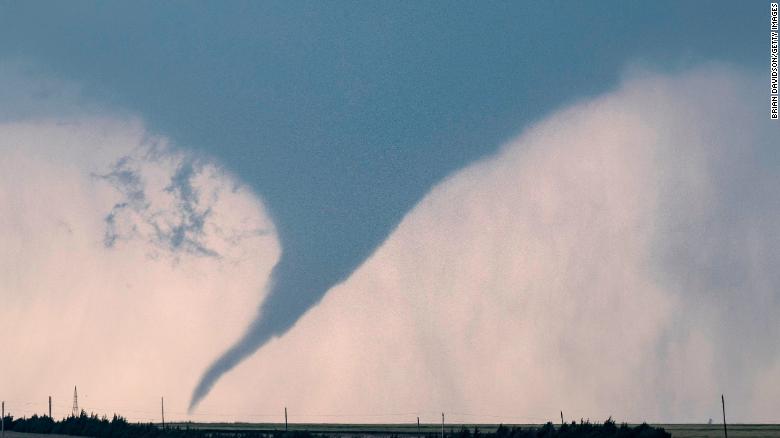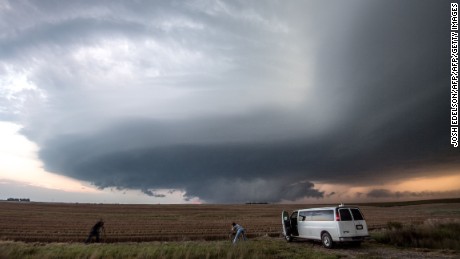(CNN)They can happen at any time and threaten every corner of the United States. It is time to prepare for one of the world's most destructive types of weather: tornadoes.
On average, the United States sees more than 1,200 tornadoes per year, far more than any country in the world.
While tornadoes can be deadly, there are steps you can take to protect yourself and your loved ones before, during and after disaster strikes.
1. Get alerts
First things first: Understand the difference between a tornado watch and tornado warning, and be able to identify your city and county on a map.
- Outdoor sirens -- While sirens can be useful, they are not always the best way to receive tornado warnings, since they are not widespread.
- Local television -- Local stations will provide on-air coverage for your area during severe weather, but the TV won't wake you up if a tornado warning occurs at night.
- NOAA Weather Radio -- While it may sound old-fashioned, a weather radio will provide you with up-to-date information straight from your nearest National Weather Service forecasting office.
- Mobile phone -- Wireless emergency alerts are one of the best ways to receive tornado warnings anytime, anyplace. In an IOS device go to settings, then notifications, and scroll to the bottom. Make sure emergency alerts -- listed under government alerts -- are clicked on. If you use a third-party app, be sure the alerts are issued in a timely fashion. Most importantly, have those notifications ON.
2. Know the safest places to shelter
There are a few places that will keep you the most sheltered in a tornado.
- Underground -- A basement or cellar is the safest place to protect yourself from a tornado's violent winds.
- The first floor in an interior room -- In a home, this place could be a bathroom or closet with no windows. Put as many walls between you and the outdoors as possible.
Things can get a little more complicated if you don't have access to a permanent structure.
- Mobile homes -- Trailers are light and will easily topple in strong winds, so they are one of the worst places to be during a tornado. If you receive a tornado warning while you are in a mobile home, you should go to the closest sturdy building. If a reliable shelter is not available, the next best option is to lie in a ditch and protect your head from flying debris.
- Cars -- The National Weather Service emphasizes that a vehicle is not a safe place to be if a tornado threatens you. Although this is true, one study found that people belted in a car are generally safer than those who stay in a mobile home. So, if you are in a vehicle during a tornado warning, exiting your vehicle and seeking shelter in the closest permanent structure is the best option. If that is not possible, experts suggest you either buckle your seatbelt and crouch down in your car or abandon your vehicle and lie in a nearby ditch.
Be sure your plan is updated and works at all times. If you plan to seek shelter in a public building, make sure it is available 24 hours a day, seven days a week. Your plans need to work at any time of the day or night.
3. Avoid dangerous places
- Under highway overpasses -- Sheltering under a bridge may seem like a good option if you are stuck in your car, but the narrow passage can act like a funnel and amplify winds.
- Outdoors -- There are no safe options if you are stuck outside during a tornado warning with no permanent shelter nearby. As an absolute last resort, stay away from trees or other free-standing objects, crouch down in the lowest-lying area you can find, and cover your head.
- Upper-level floors -- If you live on an upper floor of an apartment building or work in a tall office building, find a way to seek shelter on the first floor safely. An interior hallway can be a safe bet.
- Warehouses, department stores, grocery stores -- Structures with large open spaces are particularly vulnerable to collapse, even in relatively weak tornadoes. If possible, find a small, enclosed area to shelter in, and avoid the building's outer walls.
4. Protect yourself
- Cover your head -- The best advice is to keep a helmet handy. At the very least, cover your head with your arms. If you have time, putting a mattress over you can also help keep you safe.
- Be loud -- Meteorologists suggest that you keep an air horn or whistle wherever you take shelter, so you can be heard by first responders if you become buried by debris.
- Have supplies -- Keep some necessary first aid materials in your shelter in case there are injuries.
- Wear shoes -- If a tornado does occur, there could be hazardous debris that you won't want to step on.
- Avoid dangerous material -- If you get trapped in a damaged building, be sure to distance yourself from downed power lines, broken gas lines and sharp objects.






